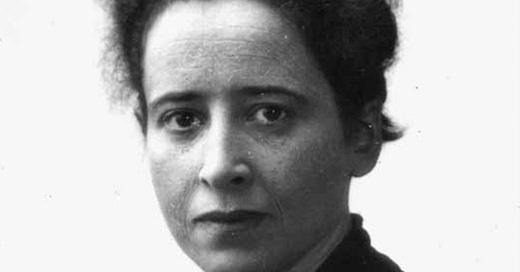Dear Reader,
I hope you’ve had a wonderful summer!
I’ve been on hiatus researching and writing my next book, which is finally taking shape. In the meantime, Hannah Arendt has appeared in the UK, and I’ve received so many lovely letters and photographs of people holding the book.
Many of you have written to me about the photographs I chose to include, and so I thought this week, upon my return, I’d tell you a bit about my favorites and why I chose them. This Tuesday please join me for an open (virtual) happy hour and tour of Hannah Arendt’s photo archive. You can RSVP here.
Hope to see you soon, S
Most publishers use the same three photos of Hannah Arendt. They are black and white, she is a bit older, and she has a very serious look on her face. So, when I started working on the biography I went looking for new photos. Surprisingly, though, there are only a couple hundred pictures of Arendt that have survived. I hoped there would be more hiding in the archives, so I went to the Library of Congress in Washington, DC to the photo division, but there were only a few more. And by few, I mean like five. Because of the historical circumstances of Hannah Arendt’s life, most of the photos that exist were taken after the war.
Of the new photos I discovered, this is my favorite.
This is Hannah Arendt’s 1933 German passport photo. She looks so fierce. I wanted it to be the cover, but my publisher resisted. Photographs often say more about how a person has become idealized in the imagination than who they were, but Arendt’s 1933 passport photo tells a story. She is almost unidentifiable. Wearing the same button down blouse seen in earlier portraits from the 1920s, she is suddenly much older. You can seen the creases in her forehead and smile lines, the stress and laughter. Taken shortly before she was arrested by the Gestapo for doing antifascist work, she is frozen in time here between past and future, between Germany and America, between home and exile.
This is Hannah Arendt as a little girl in Königsberg. Her thick hair is plaited and her hands wrest palms up in her lap. It was taken after her father Paul Arendt died from syphilis when she was seven. I wanted to include some younger photos of Arendt in the book. She wasn’t always the serious portrait of a thinker, and here you can see from a young age what a marvelous sense of humor and resilience she had. There’s a wry look on her face and a sense of peacefulness not often seen after the war.
And this is Hannah Arendt in Marbach, Germany in June 1975. You can see how exhausted she is here, sitting by an open window, cigarette unlit, staring off into the distance, mouth slightly open. She spent a month in Marbach organizing Karl Jasper’s papers in the German Literature Archive. When Arendt arrived she was in great spirits, reciting Friedrich Schiller by heart in the cafeteria, but as the month wore on she became increasingly tired. When Mary McCarthy went to visit her, she found her irritable and worn out. It was her last trip back to Germany. And Arendt died the following December from a massive heart attack.
Dealing in photographs can be tricky. How do you take a woman so alive and turn her into an object for contemplation? My hope was to offer readers an image of Arendt that was in-between youth and old age, one that might resonate more strongly with a younger audience encountering her work for the first time.
I hope you enjoy them, and I hope to see you Tuesday.
Yours,
Sam






"Hope to see you soon, S" - Und WIR erst !! - Come back well and safely 💙 Great joy, see you Tuesday.